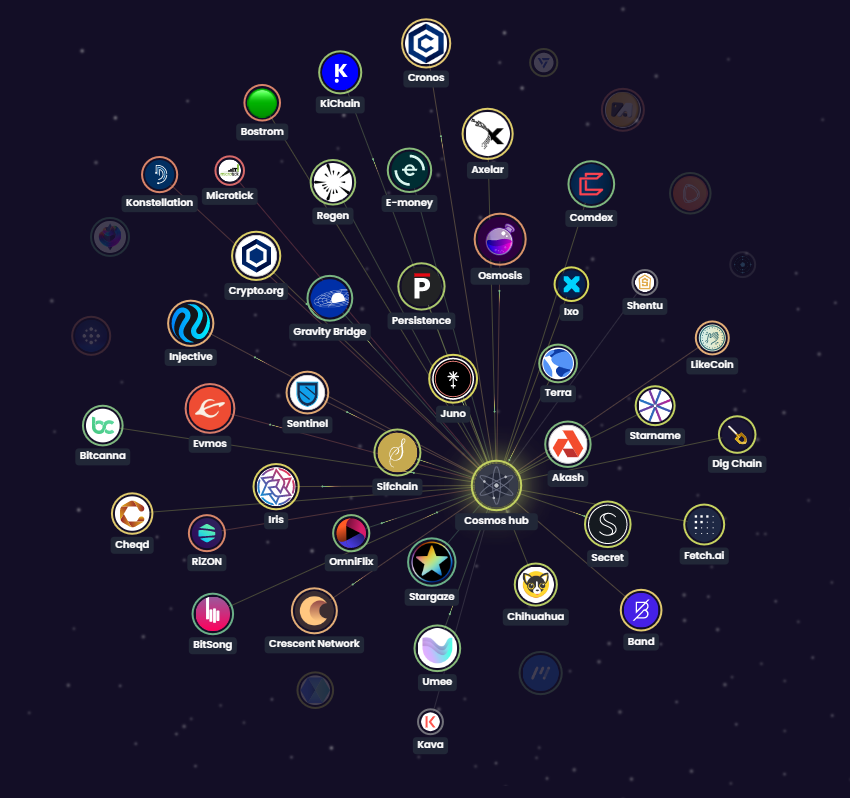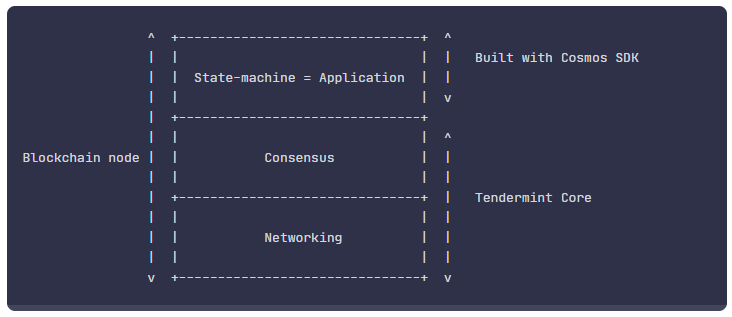Far out in the uncharted backwaters of the unfashionable end of the broader crypto marketplace lies a decent sized, but somewhat underrated project called ATOM.
Orbiting this at a variety of distances is an ever growing collection of blockchains, which have implemented various adaptations of the ATOM chains foundations, the Cosmos SDK. These chains are held together, orbiting around the Cosmos (ATOM) chain by a remarkable gravitational effect called the "Inter-Blockchain Communications Protocol" (IBC). IBC is like the Babel fish, from the Hitchhikers guide to the galaxy, an incredible tool that allows all these unique, and separate chains to be able to communicate with each other.
The Cosmos can be a confusing place at times, with the very term Cosmos itself used in a number of different ways, which can cause confusion for travelers passing by this sector of the crypto galaxy. The following post is an attempt to unravel the mysteries of the Cosmos for the casual observer, or curious bystander.


Cosmos Hub (ATOM)
The ATOM token lives on the Cosmos Hub chain. This is one of the primary projects in the IBC eco-system, has been around for years and is widely available on most Centralized exchanges, a growing number of Dex's, as well as in bridged form in other eco-systems like Binance Smart Chain. For most, it is the entry point into the broader Cosmos eco-system. The Cosmos chain is sometimes also referred to as "Gaia". To me, I consider it as the "ATOM" chain.
The chain is one of the first implementations of the Cosmos SDK (Cosmos Software Development Kit), which I'll cover in a minute. The chain itself seems to have a bit of an identity problem at the moment, with no clear direction, beyond a generally accepted push to role out "shared security". This will be an implementation that allows other chains to "rent" or become "consumer chains" to borrow the security of ATOM. These "Consumer chains" will use the Cosmos chains validators and pay with their token. Thus delegating staked ATOM's may end up producing multiple different token rewards as the ATOM validator set take care of security (or a portion of the security) for client chains.
Aside from this, a number of attempts to add a use case to ATOM have been met with conflict and division. Recently, a push by some to add CosmWasm (the Cosmos smart contract module) to the ATOM chain met with fierce resistance from some. Gravity Dex was an unsuccessful attempt at adding a Dex on the Hub. Eventually, this project was moved to its own chain, and renamed to Crescent. With Osmosis launching earlier, and capturing the first mover advantage for IBC Dex status, Crescent remains niche for now. Gravity Bridge likewise proved unsuccessful at adding a use case to the Hub. It's development was funded largely by ATOM and grants from the Interchain Foundation, but in a move seen by many as treacherous and underhanded, it ended up launching as a separate chain also.
It now appears that shared security is the big hope for adding a utility to the Cosmos Hub.


Cosmos SDK
Next term to understand is "Cosmos SDK". This is simply the open source toolkit that anyone can use to launch their own Cosmos style chain. With a vision for modular, app-specific blockchains, rather than a "one chain with many apps" approach that other eco-systems adopt (Ethereum, Solana, Cardano for example).
The goal of the Cosmos SDK is to allow developers to easily create custom blockchains from scratch that can natively interoperate with other blockchains. We envision the Cosmos SDK as the npm-like framework to build secure blockchain applications on top of Tendermint.
SDK-based blockchains are built out of composable modules, most of which are open-source and readily available for any developers to use. Anyone can create a module for the Cosmos SDK, and integrating already-built modules is as simple as importing them into your blockchain application.
Quote sourced from Cosmos SDK docs
The above quote explains it better than I can. To learn more about the Cosmos SDK, the docs are a good place to start.

As can be seen from the above visualization, Tendermint Core (a separate but related protocol) handles the Consensus and Networking architecture of any Cosmos chain, and the Cosmos SDK is the framework for the State-machine or Application built on the chain.
So, think of the "Cosmos SDK" as the toolkit for building a blockchain.

Cosmos eco-system.
The next concept, which also uses the Cosmos moniker, is the broader Cosmos eco-system. This is a whole collection of separate blockchains, each a layer 1 chain with their own validator set and token model. This is where the "App-specific" chain approach can be seen in action. The confusion here lies in how broad a definition you like to consider.
Many see the "Cosmos eco-system" covering all the IBC enabled chains. This means that chains like Binance chain (the beacon chain, not BSC) Thorchain and so on (which are built with the Cosmos SDK, but not IBC enabled) are excluded. To really stretch the definition, some even include Polygon as it is built with a modified version of Tendermint, however until it adds IBC capabilities, most don't connect that tenuous link.
For me, when I think of the Cosmos eco-system, you could more accurately describe it as the IBC eco-system. In my head, all the chains that are linked via IBC comprise the Cosmos eco-system when I hear that term. With 44 active zones (linked chains) the Cosmos is a rapidly expanding eco-system. The "Big-Bang" moment for this, and the beginning of the realization of the Cosmos ethos of being the "internet of Blockchains" was the role out of the IBC protocol.
There are numerous projects of note in the eco-system, with more announced to be coming in time. Osmosis, Juno and Evmos, plus of course Atom itself, are some of the big ones. Then we have projects like Comdex, Akash and DVPN to name just a few more. Up coming projects include the recently announced migration of dYdX, from an ETH layer 2, onto a purpose built Cosmos SDK chain.
While on the surface, the benefits for ATOM are quite limited from all this activity orbiting the Hub, the network effects are profound, and growing all the time. Many of these chains still see ATOM as the primary "store of value" in the eco-system, and are actively incorporating ATOM utility into their projects. In addition, holding and staking ATOM has been a primary requirement for numerous airdrops as new chains have launched in the Cosmos.
A great example of a project in the Cosmos Eco-system is Comdex. Comdex are building a range of DeFi products, with a focus on a new Stable-coin and a synthetic commodities platform, amongst other applications. This sort of addition adds use cases for ATOM, as it will be a key collateral token useable within the Harbor protocol (stablecoin), and the cAsset platform, as well as in the Commodo lending and borrowing platform. This is just one chain, adding multiple use cases for ATOM. Many other chains are doing likewise.

What does the future hold?
In a nutshell, more and more chains, new projects and migrating projects. The benefits of connecting to IBC are significant, and will grow over time as more functionality like cross chain accounts, cross chain CosmWasm smart contracts so on add more benefits to joining the Cosmos eco-system.
Thorchain is adding ATOM soon, making it more accessible than ever in a decentralized manner. This solidifies ATOM's role as the gateway to the Cosmos eco-system. In addition, when Thorchain add IBC to their chain, RUNE and Thorchain produced synths will be able to be moved via IBC around the Cosmos. While Thorchain's Dex will not use IBC, the benefits of adding IBC will still be substantial, for both Thorchain itself as well as the broader network of connected chains.
With 44 current active zones, IBC will be added to many many more chains in the coming years. Expect that number to rise to the hundreds, and likely into the thousands in time. As each chain adds IBC (and non Cosmos SDK chains can do so), the gravitational pull of the Cosmos will continue to grow. Expect to see even competing networks, like Solana, Polygon, Avalanche and so on add IBC capabilities.
My expectation is that the Cosmos eco-system will become like a black hole in the crypto universe, as it expands it will continue to suck in more and more projects, and build more and more connections, truly becoming the "Internet of Blockchains"


Obviously the title, intro and first image used in this post were inspired by "The Hitchhikers Guide to the Galaxy" by Douglas Adams.
Thanks for reading,
JK.
"So long, and thanks for all the fish."
If you enjoyed this post, here are some more you may like:
As a reminder, here on Leofinance you can find a dedicated hub for Comdex content and information. We would love to see more contributors come on board, and bring your own perspectives to the growing Leo community. Ask myself, or @carbonzerozone for more information.
Posted Using LeoFinance Beta

